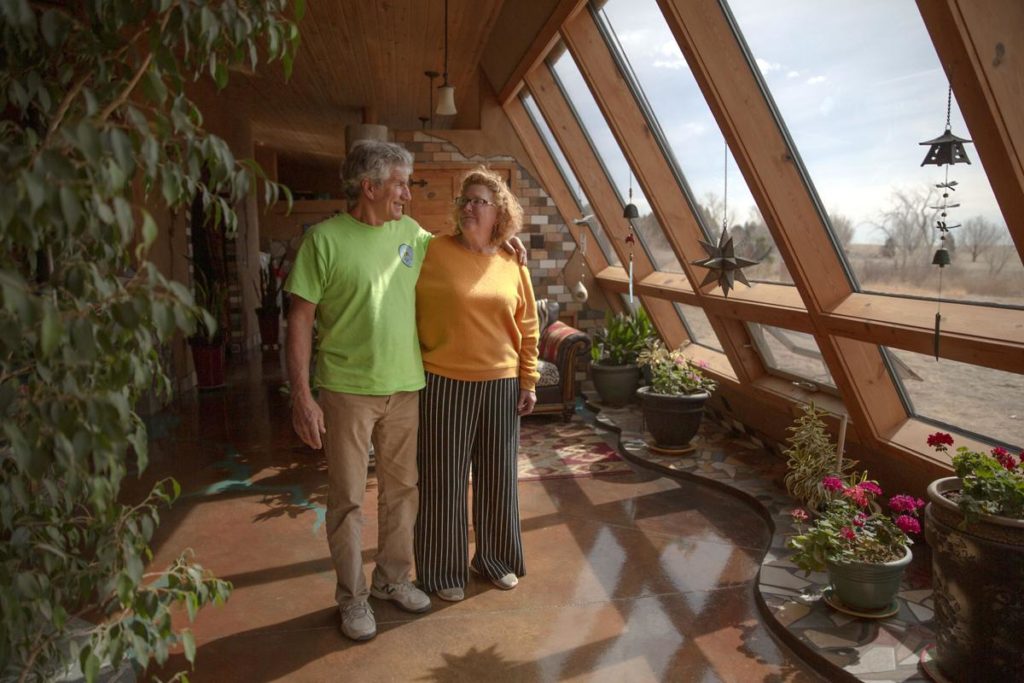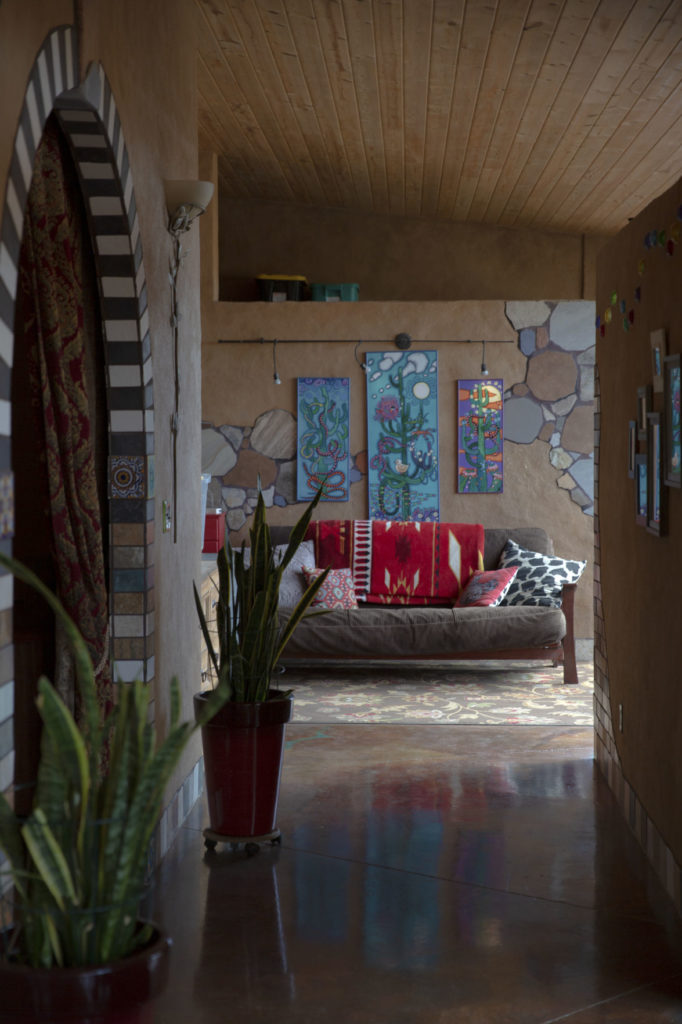Jim Gagnepain and his wife, Stephanie, built their retirement home in eastern El Paso County, Colorado. Jim, who has a background in electrical engineering, acted as the general contractor, and he and Stephanie did a lot of the work. The result is an almost completely self-sufficient bermed earth home.
Jim and Stephanie had long been interested in a zero-energy home so they turned to Michael Shealy, an engineer known for his Earthship-style homes for design help.
To begin, excavators dug into the gently sloped land to make a level surface, with the back of the house nestled into the hillside. Walls then were constructed with tire bales, which are made of compressed tires, weighing about a ton each. The bales were covered with sprayed concrete and an adobe finish was applied over that. Bales also were used for a retaining wall, and Jim estimates they used about 20,000 tires for the entire project.
The south side of the house is largely glass: 46-inch-by-76-inch angled sections with smaller windows underneath some fixed, some able to be opened. The sun streaming through those windows is what heats the house during the day; at night, the principle of thermal mass — the ability of materials such as the tire bale walls and concrete floors to retain heat — comes into play as that heat is released.
The Gagnepains have a wood-burning stove but rarely use it. They also installed inconspicuous electric wall heaters, but only because the regional building codes do not allow passive solar or wood-burning as a primary heat source.
Cooling the home during the summer is more of an issue than heating in the winter. The heat was relentless their first summer, and they had to use two big evaporative coolers to help. Since then, they’ve installed outside shades to keep the heat out; they can lift the shades and open the smaller windows to let in the cool air at night.
Water comes from a well. The appliances are electric; solar panels and a wind turbine generally supply that electricity. The water heater is a hybrid; situated near the windows, it retrieves heat from the air but also can use an electric coil to warm the water if needed.
The Gagnepains are connected to the grid. For the first several years, they ran a surplus, contributing to the grid without taking from it. Now that Jim has an electric car, that surplus is less common. “Some months we take more than we produce and vice versa,” he says.
The couple worked to save money where they could. Stephanie turned to Craigslist for stone sinks; they normally can sell for more than $2,000, but she got them for $99 each.
“All the tile in the house is from ReStore,” she says. “I did all the staining of the concrete floors myself.” Stephanie, who is an artist, also did the tiling along with other artistic touches.
The unusual home raised eyebrows at first. Neighbors who saw the tire bales coming in worried they were building a “junk house,” the couple says. Even the building inspector was dubious in the early stages, Stephanie says. “He just shook his head and said, ‘Whatever.’” Now the common response of visitors is simply awe, they say.
The Gagnepains love their home and tick off several reasons why. With the thick walls, the house is quiet. It offers a great view of the prairie and the wildlife on the south side. There are little or no utility bills. And the warmth and sunlight are great for plants. “They just flourish,” Jim says.
Any drawbacks? Jim concedes that heating and cooling take more effort than pushing a button on a thermostat. And because there’s no escape route through the back, bedrooms are open to the main hall, though curtains provide privacy.
“The biggest drawback,” Stephanie says smiling, “is I never want to leave home. We used to travel a lot. Now I’m not interested in leaving.”
You can read the original article at gazette.com where you can also watch a short video about the home.

Thank you for posting this!
We are trying to build the first tire bale home in New Mexico, and recently submitted our building plan to the state. As I understand it, Michael Shealy died unexpectedly (heart attack) in 2015, and as far as I can tell, only a handful of tire bale homes were built.
It is a promising way to deal with the endless supply of scrap tires, and vastly less labor-intensive than the Earthship method (individual tires pounded full of dirt one-by-one with a sledgehammer). We are 2 retirees and needed a less labor-intensive way.
Our house will also be a passive and active solar house with a south-facing greenhouse; earth bermed on the north side, and earth-plastered. We are off grid. We currently haul water (in a five-year arrangement with our closest neighbors) but will likely have to have a well dug eventually.
Our next step is seeing if the state grants our permit…
There is an article about tire bales at http://greenhomebuilding.com/articles/tirebales.htm and at the end of this are some links to more information that might be useful to you.
Great house from these creative folks.